
- Market information
- Be a sustainable business
- Share this on:

How to be a sustainable tourism business
For most European tourism providers today, embedding sustainability into all aspects of their business has become common practice. Before COVID-19, sustainable tourism was becoming increasingly important to the travelling public. Climate change leading to soaring temperatures, wildfires, floods, and other extreme weather events is now widely accepted to be a direct result of human behaviour. Countries, governments and citizens are urgently seeking to reduce carbon emissions, which impacts every industry in the world, including tourism.
Contents of this page
- Responsible travel choices are growing amidst climate crisis and post-COVID
- What is sustainable tourism?
- Eight elements of a sustainable tourism business
- Become certified as a sustainable tourism provider
1. Responsible travel choices are growing amidst climate crisis and post-COVID
Despite the challenges, large-scale leisure travel is still highly likely to resume once the pandemic subsides. New routines and shifting personal priorities because of COVID-19 has led to consumers reconsidering what is important to them, and the health of the planet is attracting global attention. As a result, the traveller mindset is stimulating changed travel behaviour as tourists are keen to minimise the negative effect of their travel while making a positive contribution to the destinations and communities they visit.
What does this changed tourist behaviour mean in practice?
- Choosing greener forms of transport, such as the train.
- Reducing the number of long-haul trips but staying longer.
- Contributing to carbon offsetting schemes or other community development schemes to offset their carbon footprint.
- Choosing low impact activities that are less harmful to the planet, such as outdoor sports like walking, hiking and cycling, rural tourism, wildlife watching, non-motorised water sports and cultural activities.
- Choosing service providers, such as inbound and local operators and accommodation providers, that are committed to responsible and sustainable tourism practices across their business.
- Upon arriving at a destination, staying longer, staying local.
- Engaging more fully with local communities through community-based tourism activities, staying locally rather than in large, generic hotels, eating local food.
- Avoiding ‘exploitative’ tourism that harms the environment, people and/or animals.
- Seeking authentic, unique, and small group tourism experiences.
- Learning about new cultures through immersive experiences such as food, festivals, cultural events, homestays, meeting local people.
European tourism companies are required to implement sustainability into their businesses under the European Green Deal legislation in order to meet the commitment to reduce carbon emissions to net zero by 2050. Given that European travellers are also increasingly keen to embrace sustainability, local tour operators and other tourism SMEs can improve their competitive position by investing to embed sustainability in their businesses.
For local tour operators that can meet these challenges, there are good opportunities to help save the planet and bring benefit to local communities while providing meaningful and authentic experiences to the growing number of responsible travellers.
2. What is sustainable tourism?
Sustainable tourism is defined formally by the UN Environment Programme and the UN World Tourism Organisation as, “tourism that takes full account of its current and future economic, social and environmental impacts, addressing the needs of visitors, the industry and host communities”.
Sustainability in tourism is strongly connected to the United Nations Sustainable Development Goals (SDGs), developed by the UN as a call to action to promote global prosperity while protecting the planet. Tourism is recognised as a key sector in the challenge to meet the 17 SDGs.
Figure 1: UN Sustainable Development Goals
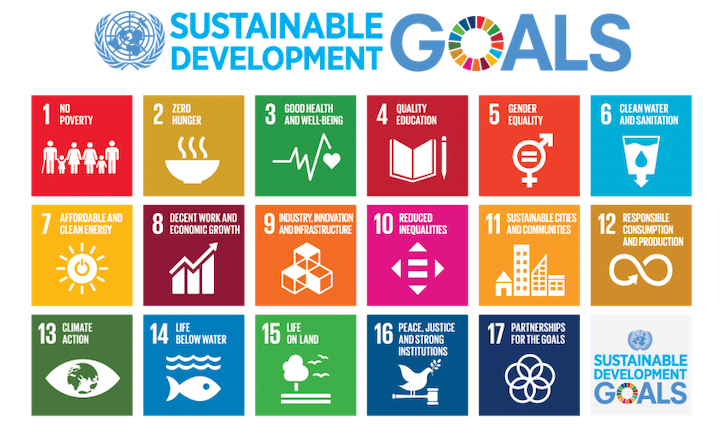
Source: UNWTO
What that means is that sustainable tourism is concerned with all the activities that are conducted by and in the tourism industry. It is about understanding and acknowledging that tourism has both negative and positive impacts on the planet, the natural environment, people and places, and taking the appropriate action to minimise the negative and maximise the positive impacts.
Table 1: Examples of Positive and Negative Impacts of Tourism
Source: Acorn Tourism Consulting
- Find out how adventure tour operators manage sustainability in tourism. The Adventure Travel Trade Association (ATTA), in association with Switzerland Tourism, has released the first report in a series of sustainability research reports that features case studies, lessons learned and best practices from all over the world, set to be published at regular intervals over the next two years. Download the first report on High Moments, Low Impact: Rethinking Adventure Travel’s Sustainability Efforts .
3. Eight elements of a sustainable tourism business
There are many ways to incorporate sustainability into your business, whether you run tours or manage tourism accommodation. It is important to understand that embedding sustainability into your business is a process that will take time. However, it should be your goal to achieve as high a level of sustainability as possible within a realistic timeframe.
If you don’t know whether your business is sustainable, use this free sustainability check to help you find out.
Figure 2: Eight Elements of a Sustainable Tourism Business
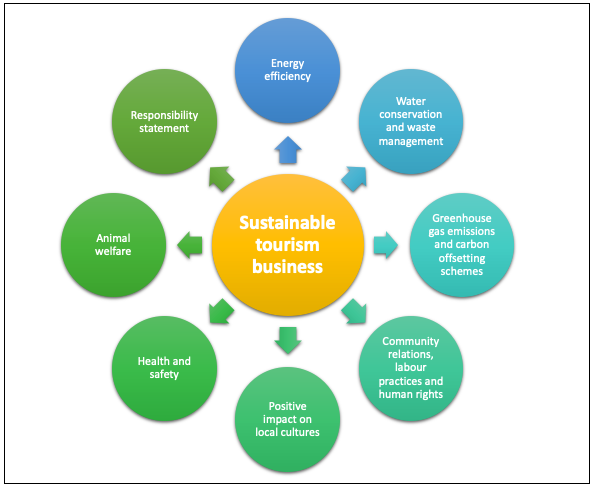
The higher the level of sustainability and the more responsibly you run your business, the greater the positive impact you will have on your environment, your community, the quality of your tourism product and client experience, and the more confidently you can promote your green credentials.
Element 1: Energy efficiency
Reducing our reliance on fossil fuels, conserving energy, and improving energy efficiency play a key role in managing the human impact on the environment. Types of energy from renewable sources, also referred to as renewables, are being adopted more widely around the world and new technologies are being developed all the time. While many systems are still very expensive, there are a wide range of small, practical steps that SMEs can take to improve their energy efficiency and monitor energy consumption.
Steps to take:
- Use renewable energy, such as electricity from solar panels or wind power, as much as possible. Choose energy suppliers that provide energy from renewable sources if possible.
- Make sure appliances such as fridges, washing machines and ovens are energy-efficient.
- Install energy-saving lightbulbs everywhere.
- Install thermostats for heating (if needed) and hot water, and a ‘smart’ meter to track your energy use to help you keep it as low as possible.
- Use electric vehicles instead of vehicles with combustion engines.
- Ask your customers/guests to be mindful, turning off lights, air conditioning and/or heating when they leave their rooms.
Figure 3: Example of Customer Notice to Conserve Energy

Source: Recycle Reminders
- Establish formal monitoring processes to measure your energy consumption on a monthly basis.
Element 2: Water conservation and waste management
The effective management of waste is at the core of any sustainable scheme. Tourism providers that adopt responsible waste practices demonstrate a high level of commitment to the preservation of the environment.
‘Reduce, Reuse, Recycle’ are the key activities in waste management, and the phrase is highly recognisable by consumers these days.
Figure 4: Recycling Waste Scheme in Action
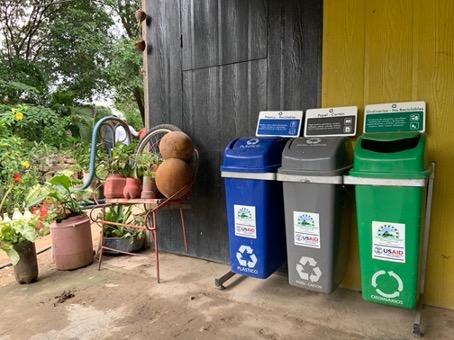
The global problem of plastic pollution is well publicised in Europe and consumers are very familiar with images of oceans and beaches contaminated with vast amounts of plastic waste. Single-use plastic, commonly used for plastic bags, water/drinks bottles, straws and plastic plates/cutlery, is widely considered to be a major culprit. Many countries have banned the use of some single-use plastics and others, such as Tanzania, have banned travellers from bringing in plastic bags to the country .
Water is an increasingly precious resource that must be managed carefully in many countries that have limited rainfall or are prone to drought conditions. As well as encouraging your customers to use water responsibly for washing and so on, you should also encourage them to use reusable water bottles and provide a supply of filtered water. This is essential in places where tap water is not safe to drink.
- “Waste is only waste when you waste it” - ensure you have a waste separation scheme in place for recycling paper and cardboard, plastics and aluminium and ensure it is all disposed of responsibly according to the regulations in your destination.
- Consider whether you could support a ban on single-use plastics in your business or commit to working towards an outright ban.
- Compost food and garden waste appropriately.
- Install low-flow taps and shower heads.
- Install a rainwater harvesting system for crops/gardens, and/or flushing toilets.
- Install a water filtering system to encourage guests to limit their use of plastic bottles. Provide (loan, sell or give) your clients reusable bottles. They can be company-branded souvenirs.
- Display customer signs to use water sensibly and turn off taps.
- For accommodation providers, implement a reuse towels and bedlinen scheme.
- Encourage visitors to take part in a litter collection initiative.
Figure 5: Customer Notices: Reuse Bedlinen/Towel Scheme and Conserving Water

Source: Acorn Tourism Consulting/Key Signs
- Make sure you are aware of the regulations surrounding waste and recycling in your destination. Check what initiatives there may be to help you improve your waste management practices.
- Establish a formal monitoring process to measure your water usage on a monthly basis.
Element 3: Greenhouse gas emissions and carbon offsetting schemes
Reducing carbon emissions is the most important factor to address climate change. Carbon dioxide (CO2) accounts for around 80% of greenhouse gas emissions and its presence in increasingly high concentrations is the major cause of climate change. Burning fossil fuels, commonly practised in the manufacturing and aviation sectors, deforestation, and intensive farming practices are major contributors to harmful levels of carbon dioxide and other greenhouse gases in the atmosphere.
The effects of climate change are causing serious problems for human life all over the world due to floods, storms, wildfires, and extreme temperatures. Rising sea temperatures are devastating coastal communities and damaging delicate ecosystems that cannot adapt quickly enough, which in turn threatens the many species that live in them.
To compensate for the emissions caused by tourism activities, many European tour operators make contributions to carbon offsetting schemes. Travellers also like to know that operators they use and places they visit are helping to address the issue by contributing to schemes and actively choose providers that make a conscious effort to minimise the impact of travel.
However, carbon offsetting is a controversial topic. It is becoming more widely understood that for carbon offsetting to work, activities must be carried out in addition to any existing scheme. Therefore, it is important to select offsetting schemes that really consider the positive impact they make towards addressing climate change.
You can see how UK operator Much Better Adventures carefully considers which reforestation and rewilding schemes to support for maximum benefit to the planet.
- Measure your carbon footprint using an online calculator such as Carmacal , developed specifically to measure the carbon footprint of tour and travel packages.
- Read more about the effects of climate change so that you are knowledgeable about the global issue. Greenpeace is a good source of information.
- Do your own research into companies that you can sign up with for carbon offsetting schemes, like Earthly . Some schemes, such as German organisation Atmosfair , support the development of tourism practices using renewable energy.
- Research what carbon offsetting schemes exist in your country or destination.
Element 4: Community relations, labour practices and human rights
Employing local people in your business is crucial for tourism to be sustainable. Local individuals benefit both economically and from a personal development perspective. It can also have a positive impact on their whole family and help foster a sense of local and national pride.
However, it is important to ensure that everyone involved in your business, including staff and volunteers, are treated fairly, do not work excessive hours or in poor conditions. They should have at least one full rest day a week and receive adequate training for the work they are expected to do.
It is also important to involve and consult with other local stakeholders, both in the planning and implementation stages. You must build strong relationships with them to ensure success at a community level and to be able to deliver an immersive experience for the traveller.
A Code of Conduct that encompasses all your business practices is essential. It should clearly state your support of human rights, that you distance yourself from child abuse and, if applicable, your commitment to animal welfare in tourism. You should research other companies’ Codes of Conduct to help you write your own, for instance:
- Intrepid Travel Responsible Travel Code of Conduct
- Rainbow Tours Code of Conduct
- ABTA’s Welfare of Animals in Tourism
- GAdventures’ Child Welfare and the Travel Industry – Global Good Practice Guidelines
- If you are setting up a community tourism project, identify all the stakeholders and what role they will play in the project, whether a supplier, buyer, community, family, group/organisation or employee or consultant.
- Employ staff from the direct community whenever you can, followed by the local area and region. Ensure that each role is supported by a formal job description and that training is provided as necessary.
- Build a network of knowledgeable and experienced guides who are enthusiastic and speak the language of the travellers to a good standard. They must be able to bring the product alive, whether guiding a walking trail, identifying bird life, conducting community village or historical tours, and so on. Offer training as necessary.
- Pay a fair wage for the work they do and the skills they have.
- Do not exploit children. They should not be employed by the business or be involved in anything dangerous, or if it means they miss school. For more advice on establishing a Code of Conduct, consult The Code of Conduct for the Protection of Children from Exploitation in Travel and Tourism .
Element 5: Maximising positive impact on local cultures
Maximising the authenticity of an experience for a visitor through meaningful interactions with local cultures and communities is at the heart of sustainable tourism activities. Community-based tourism (CBT) is a fast-growing niche market within the tourism industry, driven by travellers keen on unique and authentic experiences.
For instance, a guided walk or tour through a village combined with a traditional activity like cooking with a local family, or taking part in hands-on village activities like handicraft making or harvesting fruit or flowers. It is important to ensure the whole community is involved in supporting or providing the experience – and that a structure is in place that enables everyone in the community to benefit from selling the experience.
If your business serves food, it is important to ensure that produce is locally grown, harvested and/or produced, and is seasonal. Local and seasonal is a key part of sustainability. Sourcing from local producers and growers under fair terms and conditions ensures positive impact.
Other examples of activities, trips and experiences that can be organised sustainably to the benefit of both community and visitor include:
- Birdwatching
- Wildlife watching
- Nature walks, learning about unusual flora and fauna or traditional plant-based medicines
- Visiting a coffee or sugar cane farm
- Visiting a local community and joining in with traditional activities
- Guided walks with storytelling, visiting interesting historic sites
- Sharing local music and culture, such as traditional performances or visits to local festivals
- Opportunities to try traditional food and drink
- Language classes
- Watching and learning about traditional handicrafts, including the opportunity for tourists to try it themselves
- Food tasting
- Traditional cookery classes including a trip to the local market to buy ingredients
- Art, painting or photography
Element 6: Health and safety
Ensuring guests’ health and safety is of paramount importance for all tourism providers. It has become even more important because of the pandemic, and you must establish some robust cleaning and sanitising protocols, making sure you are very clear what they are. If you supply travel products to European tour operators, they will also expect you to be very clear how you will keep their customers safe.
Your website is the best place to promote your COVID-19 safety protocols. Take a look at this comprehensive COVID-19 Operating Plan for staff and guests drawn up by local Indian operator Village Ways to give you some ideas for developing yours.
You can also consider signing up to join the World Travel & Tourism Council’s Safe Travels stamp, a self-certify scheme to help rebuild confidence among travellers so safe travel can resume once restrictions are eased. It is free to use, provided that you commit to the implementation of and ongoing compliance with the Safe Travels protocols. Download the WTTC Safe Travels Protocols to find out more.
- For more information about managing your business during COVID-19, download the CBI study on How to respond to COVID-19 in the tourism sector.
Element 7: Animal welfare
The welfare of animals in tourism is an emotive topic for European travellers. There is a lot of negative publicity surrounding poorly managed animal wildlife attractions that promote unacceptable practices, including forced animal performances and the handling of wild animals. There are many campaigning organisations in Europe and around the world that actively encourage wildlife tourists to stay away from such attractions, for instance Four Paws and Animondial .
Increasingly, European tour operators will only work with suppliers that promote very high standards of animal welfare, both for animals that live in the wild and those living in captivity, such as conservation sanctuaries. They will not buy from you if you cannot prove you are a responsible wildlife tourism provider.
- You should familiarise yourself with what are acceptable practices in animal tourism these days. Consult ABTA’s Animal Welfare Guidelines for more information.
- Assess your tourism product thoroughly to ensure it complies and make changes if it does not.
- For more information about requirements for wildlife tourism products, including detailed information about developing sustainable wildlife tourism products, consult the CBI study on Entering the European market for wildlife tourism products .
Element 8: Responsibility Statement
To communicate your commitment to sustainable tourism, you should write a Responsibility Statement for your business. The statement should clearly outline all the sustainable activities that you practise, but it is important that you are honest about what you do and that you don’t exaggerate or make any false claims. You will seriously harm your business and reputation if your claims are discovered to be false.
The statement must provide your visitors with a clear view of the proactive environmental and social measures that your businesses has adopted and others that you aspire to reach. This is important as it shows that you are aware there is always more that can be done, and it is a good thing to have goals.
This is a good example of aspirational thinking.
Figure 6: Next Steps
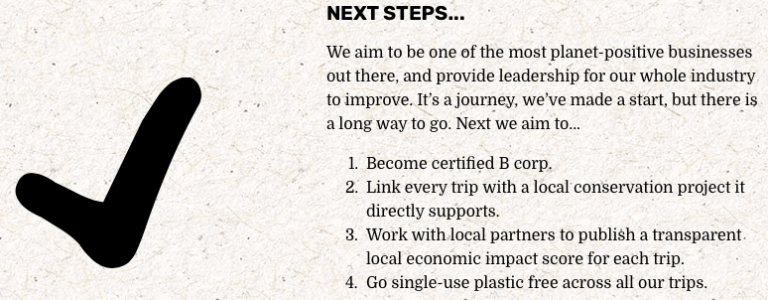
Source: Much Better Adventures
For inspiration when writing one for your business, look at these examples of responsibility statements from tour operators and tourism providers:
- Intrepid Travel – as one of the world’s leading tour operators of sustainable holidays to destinations all over the world, its responsibility statement is extremely comprehensive and covers many themes of responsible and sustainable tourism practices.
- Responsible Travel – is an Online Travel Agent (OTA) of responsible holidays. Its mission is to ‘make the travel and tourism industry more caring’ and it has a very detailed responsible tourism policy.
- Village Ways, India – has a strong but simple responsibility statement that focuses on five main themes.
- The Black Sheep Inn, Ecuador – this ecolodge in the Andes Mountains has an impressive goal to be self-sufficient in energy, water and food production. It clearly outlines all the sustainable and conservation activities it undertakes, including detailing the reasons why composting toilets and harnessing solar energy is a good idea.
- Lapa Rios Ecolodge, Costa Rica – sustainability is the core value of this ecolodge with nature conservation and community development at the forefront of its activities.
- Make sure the statements you make are clear and honest.
- Do not exaggerate your claims or make vague statements.
- Avoid ‘ greenwashing ’ – do not pretend you are doing something that you are not. It will harm your reputation when it is discovered.
- Avoid 'greenhushing' – by underreporting your sustainability achievements to your clients
4. Become certified as a sustainable tourism provider
Being certified as a sustainable business sends out a strong message to your customers that you understand the issues and are working hard to minimise negative impacts and maximise positive impacts of your tourism business.
The Global Sustainable Tourism Council , commonly referred to as the GSTC, manages the global standards for sustainable travel and tourism, and acts as the international accreditation body for sustainable tourism certification.
Figure 7: Global Sustainable Tourism Council Logo

Source: GSTC
The GSTC Criteria are applicable to all sectors of the tourism industry and organised around four main themes:
- Effective sustainability planning
- Maximising social and economic benefits for the local community
- Enhancing cultural heritage
- Reducing negative impacts on the environment
There are two sets of GSTC Criteria:
- Industry Criteria for Hotels and Accommodation Providers , and Tour Operators
- Destination Criteria for policymakers and destination managers.
Tour operators and accommodation providers may apply for sustainable certification directly with GSTC or apply to join a scheme that has adopted the GSTC Criteria within its own system and has been recognised by GSTC as GSTC-Recognised Standards.
Table 2: Examples of GSTC-Recognised Standards
Source: GSTC/Acorn Tourism Consulting
To illustrate the importance of sustainability certification to adventure tour operators around the world, the Adventure Travel and Trade Association (ATTA) 2021 Adventure Tour Operator Snapshot Survey identified that 40% of respondents were either working towards sustainability certification or were certified already.
Figure 8: Sustainability Certification among Adventure Tour Operators
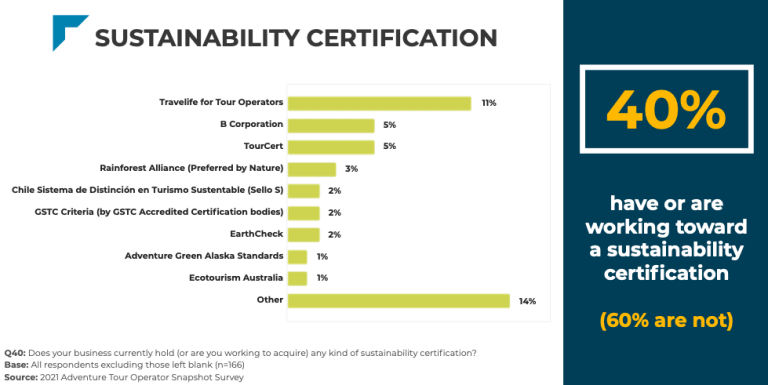
Source: ATTA
- Do your own research into the different sustainability certification schemes to see which would be most suitable for your business. Make sure you explore any national schemes that are available in your country too.
- Have a look at this website, bookdifferent.com , an OTA (online travel agent) offering a range of sustainable hotels and other eco-friendly accommodations all over the world. If you want to list your property on this OTA, you will be referred to a partner-ecolabel to begin the certification process.
TO BECOME CERTIFIED AS A SUSTAINABLE BUSINESS, OR NOT?
If you cannot afford to become certified sustainable at this stage, you should incorporate sustainable practices in all your businesses activities as far as you are able to, and make sure that you record your activities and use your website to tell the story about your sustainability. Although certification is desirable, travellers will also be interested to know that your activities are sustainable and have a positive impact on the environment, people and local economy.
Travelife for Tour Operators
Travelife is an internationally recognised GSTC-accredited training, management and certification initiative for tour operators committed to reaching sustainability, with more than 400 members worldwide. Travelife is one of the best known sustainable tourism certification systems and widely adopted in Europe, so many operators in developing countries choose this standard for their business.
Travelife offers two separate but interrelated sustainability systems, one for tour operators and travel agencies, the other for hotels and accommodation providers. Benefits of joining the tour operator scheme include:
- Guidelines and templates for sustainability policies and contracts for internal and external implementation of sustainability.
- A personal coach (or trainer) to advise and support your organisation through the implementation stage.
- An online assessment of your activities and verification of your sustainability report.
- Seven online training courses for your staff and suppliers.
- The Travelife Award (subject to compliance with the Travelife requirements and standards).
- Five free calculations for your tour package’s carbon emissions.
Travelife Standard, Criteria and Tools
The Travelife Standard integrates management and performance criteria and is based on leading international sustainability and Corporate Social Responsibility (CSR) guidelines. These include the GSTC criteria ; ISO 14001 in Environmental Management and ISO 26000 in Corporate Social Responsibility Guidelines and Principles. The Travelife criteria have been developed around the major sustainability themes, detailed in the following table. In addition, specialist tools have been created to help members address these issues.
Table 3: Travelife Sustainability Themes and Tools to Address Sustainability Issues
Source: Travelife/Acorn Tourism Consulting
Travelife Certification Process
There is a three-stage approach to achieve sustainability certification under the Travelife scheme. Applicants usually complete each stage before progressing to the next.
Figure 9: The Stages of Travelife Sustainable Certification
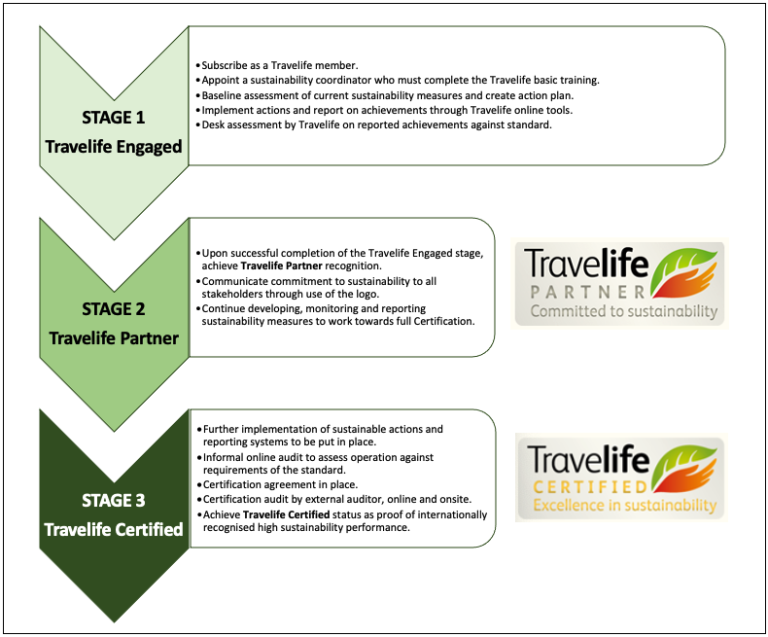
To find out more about the three stages, also known as packages, visit Travelife’s membership packages page.
Travelife members are found across the tourism industry and include travel trade associations which promote Travelife to their members, such as ABTA (Association of British Travel Agents) and ANVR (Netherlands Travel Trade Association). You can also browse Travelife’s current tour operator and travel agent members, arranged by country here .
When it comes to accommodation providers, many leading companies have joined Travelife to help improve sustainability in their own accommodation supply chain, like TUI and Hotelplan .
- If you organise trips, tours and experiences, consult the Travelife website to make sure you understand the requirements for certification.
- For more information about the Travelife sustainability programme for accommodation providers such as guest houses, hotels, hostels, and other tourism accommodation, visit the website, Travelife Accommodation Sustainability .
This study was carried out on behalf of CBI by Acorn Tourism Consulting Limited .
Please review our market information disclaimer .
Enter search terms to find market research
Do you have questions about this research?
Ask your question
Sustainability in tourism is on the edge of a breakthrough. Present day consumers expect companies to minimize their environmental impact and maximize their social returns. More and more outbound operators expect their partners to work on sustainability. This offers a major competitive advantage for inbound operators who have reached certification. Certification is achievable for all companies, large and small and in all destinations. We do not expect you to do the impossible or anything which does not make business sense. To help businesses we have developed a comprehensive and inspirational training and tool package to lead you through the process and provide international recognition. Naut Kusters – General Manager, Travelife for Tour Operators
My advice to local tour operators would be to build sustainability into the heart of your business. Think carefully about all the positive and negative impacts your business has on the environment and communities where you operate. Make and implement a clear plan to maximise the benefits and minimise the burdens. This will mean you can confidently communicate your approach, your progress and successes to the companies you do business with. Work closely with others in the destination where you operate to share challenges and solutions, and most of all emphasise how being a sustainable travel company offers a better customer experience – one that’s local, authentic, special and memorable. Rebecca Armstrong, Destinations Programme Office, The Travel Foundation
Related research
- What is the demand for outbound tourism on the European market?
- What trends offer opportunities or pose threats on the European outbound tourism market?
- What are the requirements for tourism services in the European market?
- (opens in a new tab) Twitter
- (opens in a new tab) Facebook
- (opens in a new tab) LinkedIn
To read this content please select one of the options below:
Please note you do not have access to teaching notes, green entrepreneurship in tourism.
The Emerald Handbook of Entrepreneurship in Tourism, Travel and Hospitality
ISBN : 978-1-78743-530-8 , eISBN : 978-1-78743-529-2
Publication date: 11 July 2018
This chapter aims to discuss the key issues of green entrepreneurship in tourism (GEiT), paying special attention to the environmental performance of green entrepreneurs and its relationship with strategy, brand reputation and long-term business growth.
Methodology/approach
Literature review is conducted on conceptual issues and several hotels first-hand experiences that were categorised to provide readers with business-world examples.
This chapter highlights how small- and medium-sized entrepreneurs are the agents who started green innovation initiatives and how larger corporations tested and validated them. A myriad of small green interventions awaits to be undercovered and implemented. Most of them can bring financial improvements to the entrepreneurs as the required initial investments are not necessarily high.
Research limitations/implications
This chapter is explorative in nature, based on a literature review and interviews-based analysis of consolidated green initiatives, most of them being successful ones.
Practical implications
The forces driving green initiatives are identified and classified. Most important categories of green entrepreneurs are described and emphasis was placed on the managerial and marketing benefits linked to green initiatives and action plans.
Originality/value
This chapter presents models and concepts in an integrated way, facilitating a useful knowledge for prospective entrepreneurs wishing to acquire a better understanding of the opportunities and challenges related to eco-friendly business.
- Green entrepreneurship
- Green initiatives/action plans
- Case studies
- Environmental performance
Acknowledgements
Acknowledgement.
The authors wish to thank the financial support provided by The Spanish Government: Research Projects RETOS 2016, ECO2016-75961-R and ECO2016-79659-R.
Alonso-Almeida, M.d.M. and Álvarez-Gil, M.J. (2018), "Green Entrepreneurship in Tourism", Sotiriadis, M. (Ed.) The Emerald Handbook of Entrepreneurship in Tourism, Travel and Hospitality , Emerald Publishing Limited, Leeds, pp. 369-386. https://doi.org/10.1108/978-1-78743-529-220181027
Emerald Publishing Limited
Copyright © 2018 Emerald Publishing Limited
We’re listening — tell us what you think
Something didn’t work….
Report bugs here
All feedback is valuable
Please share your general feedback
Join us on our journey
Platform update page.
Visit emeraldpublishing.com/platformupdate to discover the latest news and updates
Questions & More Information
Answers to the most commonly asked questions here
Green Tourism
- Living reference work entry
- Latest version View entry history
- First Online: 08 December 2022
- Cite this living reference work entry

- Pedro Pintassilgo 3
21 Accesses
The concept of green tourism has evolved over time and is presently used with different meanings. The original one, spread during the 1980s, stands for small-scale tourism which involves visiting natural areas while minimizing environmental impacts. In this line, green tourism has been used interchangeably with such concepts as ecotourism, nature tourism, and rural tourism (Sung-kwon et al. 2003 ). Businesses have generally adopted a broader meaning for green tourism: any tourism activity operating in an environmentally friendly manner.
Recently, international organizations have defined the notion in line with the concept of sustainable tourism, which also considers other dimensions than environmental protection. In fact, for the World Tourism Organization, green tourism consists of “tourism activities that can be maintained, or sustained, indefinitely in their social, economic, cultural and environmental contexts” (UNWTO 2012 : 1). For the United Nations Environment Programme, green...
This is a preview of subscription content, log in via an institution to check access.
Access this chapter
Institutional subscriptions
Line, Nathaniel, Lydia Hanks, and Li Miao. 2017. Image matters: Incentivizing green tourism behavior. Journal of Travel Research 57 (3): 296–309.
Article Google Scholar
Pintassilgo, Pedro, Patrícia Pinto, Andreia Costa, António Matias, and Maria Helena Guimarães. 2021. Environmental attitudes and behaviour of birdwatchers: A missing link. Tourism Recreation Research . https://doi.org/10.1080/02508281.2021.1920755
Sung-kwon, Hong, Seong-il Kim, and Jae-hyun Kim. 2003. Implications of potential green tourism development. Annals of Tourism Research 30: 323–341.
United Nations Environment Programme. 2011. Towards a green economy: Pathways to sustainable development and poverty eradication . Geneva: United Nations Environment Programme.
Google Scholar
UNWTO. 2012. Tourism in the green economy: Background report . Madrid: World Tourism Organization.
Download references

Author information
Authors and affiliations.
Faculty of Economics and Center for Advanced Studies in Management and Economics (CEFAGE), University of Algarve, Faro, Portugal
Pedro Pintassilgo
You can also search for this author in PubMed Google Scholar
Corresponding author
Correspondence to Pedro Pintassilgo .
Editor information
Editors and affiliations.
School of Hospitality Leadership, University of Wisconsin-Stout, Menomonie, WI, USA
Jafar Jafari
School of Hotel and Tourism Management, The Hong Kong Polytechnic University, Hong Kong, Hong Kong
Honggen Xiao
Section Editor information
Makerere University Business School, Kampala, Uganda
Peter U. C. Dieke PhD
Rights and permissions
Reprints and permissions
Copyright information
© 2022 Springer Nature Switzerland AG
About this entry
Cite this entry.
Pintassilgo, P. (2022). Green Tourism. In: Jafari, J., Xiao, H. (eds) Encyclopedia of Tourism. Springer, Cham. https://doi.org/10.1007/978-3-319-01669-6_264-2
Download citation
DOI : https://doi.org/10.1007/978-3-319-01669-6_264-2
Received : 18 May 2021
Accepted : 24 June 2022
Published : 08 December 2022
Publisher Name : Springer, Cham
Print ISBN : 978-3-319-01669-6
Online ISBN : 978-3-319-01669-6
eBook Packages : Springer Reference Business and Management Reference Module Humanities and Social Sciences Reference Module Business, Economics and Social Sciences
- Publish with us
Policies and ethics
Chapter history
DOI: https://doi.org/10.1007/978-3-319-01669-6_264-2
DOI: https://doi.org/10.1007/978-3-319-01669-6_264-1
- Find a journal
- Track your research
Six trends shaping new business models in tourism and hospitality
As destinations and source markets have changed, tourism and hospitality companies have evolved too. Six key trends have shaped business models in this sector over the past decade.
About the authors
This article is a collaborative effort by Caroline Tufft , Margaux Constantin , Matteo Pacca , and Ryan Mann , with Ivan Gladstone and Jasperina de Vries, representing views from McKinsey’s Travel, Logistics & Infrastructure practice.
In accommodation, asset-light models like franchising and management have proliferated, though luxury and small-scale brands are opting out. Consolidation has driven economies of scale. Hotels are looking to reclaim their relationship with guests, and almost two decades in, home sharing is charting its own course.
In the experiences space, reinvention is the name of the game. Cruises and theme parks have both focused on attracting new demographics while fine-tuning their revenue management strategies. Experiences remains a highly fragmented, legacy sector, creating massive opportunity for those able to crack the code on aggregation.
By considering the six trends, tourism and hospitality companies can gain insights on business practices for today—and on areas of future opportunity.
Accommodation: New models and value propositions
Large hotel brands have increasingly turned away from hotel ownership, scaling their business through franchising and management instead. The move is paying off. We find there is a 0.84 correlation between a hotel company’s share of franchised properties and its net profit margin.
Not all of hospitality is embracing asset-light model, however. Luxury hotel chains have resisted the trend, largely retaining in-house ownership to control standards. And smaller brands may find that they cannot reach the economies of scale that make the math of a franchise business work—focusing instead on creating distinctive experiences on a smaller scale.
Consolidation set the stage for the past decade. Several hotel brands quickly grew their foothold in key geographies and customer segments through strategic acquisitions, achieving economies of scale along the way.
As major hotels take a breather from a series of substantial acquisitions, further mergers between large hotel brands seem unlikely. However, tuck in acquisitions to target key growth demographics, like the luxury and youth categories, are likely to continue.
Another trend on the horizon is direct booking. Long reliant on online travel agencies, hotels are looking to reclaim their relationships with customers—both to cut down on intermediary booking fees and to learn more about their guests. Hotels are encouraging direct bookings through a variety of levers, ranging from best-rate guarantees to higher reward-earnings rates and improved mobile applications. 1 For example, Hyatt offers a best-rate guarantee for booking on hyatt.com and Marriott International is growing direct bookings. For more, see “Marriott sees record direct bookings at its hotels,” Skift, May 4, 2022.
Home sharing is here to stay. The segment has grown from 10 to 14 percent of booking value between 2017 and 2023, experiencing ups and downs in profitability along the way.
Recently, home sharing has positioned itself as more than a stand-in for traditional hotels. Airbnb’s recent advertising campaign “Get an Airbnb” leaned into the differences of home sharing from other hospitality offerings, emphasizing the space and privacy that renting a house can offer. 1 Samantha Shankman, “‘Get an Airbnb’ campaign challenges hotels,” Skift, August 30, 2023.
Home-sharing companies have also become a key distribution channel for smaller hotels, as they can offer more control over inventory and lower fees than other channels. In 2019, Airbnb reported a 152 percent increase in the number of rooms available for booking through its platform in boutique hotels, bed and breakfasts, and resorts. 2 “More hotels are using Airbnb,” Airbnb news release, January 16, 2019.
Experience providers: New segments and revenue streams
Cruises may only account for 2 percent of the overall travel and tourism market, but they have achieved 6 percent yearly revenue growth in the past decade. 1 McKinsey analysis of publicly listed tourism and hospitality companies’ Form 10-Ks. Attracting new travelers and providing new experiences have been key growth strategies.
Luxury hotels are capturing the new-to-cruising segment with the launch of yacht brands, purposefully positioned as a distinct experience from traditional cruises. Meanwhile, millennials are challenging stereotypes about cruising: of all cruise passengers, they are the demographic most likely to say they plan to cruise again (88 percent). 2 State of the cruise industry 2023: September 2023 update, CLIA, September 2023.
In parallel, cruises have fine-tuned their profitability through economies of scale and new revenue streams. Megaships have become the new normal, as ships with over 3,000 berths have grown from 27 to 47 percent of the global cruise fleet since 2015. Ancillary purchases such as onshore excursions and onboard casinos have also become a major source of growth, now accounting for 30 percent of revenue on average. 3 Calculated using the weighted average based on 2023 Form 10-Ks statements of publicly listed cruise companies.
Theme park attendance has grown 3 percent a year over the past decade, as theme park providers capitalize on new demographics and refine their revenue management strategies. 1 Global attraction attendance report , joint report from AECOM and Themed Entertainment Association, 2019.
Two new groups of visitors in particular are powering growth. First, the Asia–Pacific region accounted for much of the growth in theme park attendance in the past decade: of the total number of new visitors between 2013 and 2018, 57 percent were from Asia. Second, millennials are heading to parks in greater numbers, and not just for their children. A similar proportion of millennial parents (78%) and millennial nonparents (75%) say they are interested in going to a theme park. 2 Morning Consult survey, 2,201 participants, June 14–19, 2018.
To increase value from growing attendance, theme parks have become increasingly sophisticated in the field of revenue management. Demand-based pricing, tiered annual passes, and skip-the-line fees are all poised to go from pioneering to widespread practices.
Experiences are increasingly important to travelers, but the segment remains a highly fragmented space. Operators of activities ranging from walking tours to snorkeling outings tend to be small businesses with a limited digital presence.
This has created an opportunity for tech-forward companies to help travelers discover and book experiences. Destination marketing organizations have long played a role in this. For instance, VisitScotland helps visitors discover interesting activities like attending Harry Potter filming locations and whiskey tastings.
Several private companies that offer online discovery and booking platforms for travel activities, like Viator, GetYourGuide, and Klook, have achieved considerable growth in the US, European, and Asian markets. 1 Yeoh Siew Hoon, “GetYourGuide gets into pole position to win in $250b experiences market,” WIT, September 20, 2023. GetYourGuide grew its revenue fourfold between 2022 and 2023, Viator revenue was up 49 percent for the same time period, and Klook reported twice as many new customers in 2023 as in 2019. 2 “Klook completes US$210 million funding, embarks on a new era of profitable growth,” Klook news release, December 6, 2023; Mitra Sorrells, “With speculation of a sale in the air, Tripadvisor reports record revenue driven—again—by Viator,“ Phocus Wire, February 14, 2024.
Looking forward: Strategies to stay ahead of the curve
Where does this leave tourism and hospitality companies? Companies in any given sector tend to follow a power law curve : a small share of companies account for an outsize portion of both profits and losses. The tourism and hospitality sector is no different.
Over the past decade, publicly listed accommodation and experience providers grew revenue at 3 percent and 4 percent, respectively, roughly in line with global GDP growth. Accommodation providers increased their profits by five percentage points, while experience providers remained at an 18 percent average profit margin.
As stakeholders gear up for the next decade, there are things that businesses across the sector can do to sustain their hard-won growth—and profits. Moving forward, three strategies in particular can help tourism and hospitality companies stay on the leading edge of innovation.
Unbundle offerings
Hotel and experience providers can take a page from the airline playbook by unbundling rates and letting consumers pay for the exact experience they want. For example, at the time of booking, hotels can present guests with an individually priced bundle for a room on a higher floor, including breakfast and free parking—features that the guest’s past behavior suggests they would particularly value. Ensuring that guests can find their ideal room can lead both to increased revenue and increased satisfaction. A major hotel brand reported that guests chose to spend an additional $22 per night, on average, to customize their hotel room to their liking. 1 “IHG Hotels & Resorts revolutionizes booking experience through next-gen cloud solutions,” InterContinental Hotels news release, September 12, 2023.
Cross-sell exclusive experiences
For accommodation and transportation companies, partnering with experience providers to cross-sell a full journey provides an opportunity to tap into a growing area of traveler spending—and a chance to deepen the relationship with customers as a vacation creator. For example, airlines can partner with museums to offer discounted rates if booked at the time of the flight, or hotels can partner with a historical site nearby to offer early-hours admission. For uptake rates to become significant, the partnership needs to add value beyond mere cross-selling. Offering features like insurance or an option to buy now and pay later is one way to add value; creating a distinctive experience like a combined train and historic hotel journey is another.
Embrace a data-powered strategy
Tourism and hospitality entities individually hold a treasure trove of untapped data. Take Paris: hotels may see a surge in bookings for the “shoulder season.” Experience aggregator platforms might see that street food tours have attracted rising interest. Social media might reveal that a particular neighborhood is exploding in popularity. What special guest experiences could be created by combining these insights? Stakeholders can unlock new revenue streams by thinking through what data they hold that can be of value to others. More broadly speaking, combining multiple sources of data can help guide a strategy of unbundling and cross-selling to create more gratifying and pertinent experiences for travelers around the world. Embracing data isn’t just smart—it’s the future of travel.
Caroline Tufft is a senior partner in McKinsey’s London office, Margaux Constantin is a partner in the Dubai office, Matteo Pacca is a senior partner in the Paris office, Ryan Mann is a partner in the Chicago office, Ivan Gladstone is an associate partner in the Riyadh office, and Jasperina de Vries is an associate partner in the Amsterdam office.
The authors wish to thank Abdulhadi Alghamdi, Alessandra Powell, Alex Dichter, Cedric Tsai, Diane Vu, Elisa Wallwitz, Lily Miller, Maggie Coffey, Nadya Snezhkova, Nick Meronyk, Paulina Baum, Peimin Suo, Rebecca Stone, Sarah Fellay, Sarah Sahel, Sophia Wang, Steffen Fuchs, Steffen Köpke, Steve Saxon, and Urs Binggeli for their contributions to this article. The authors also wish to thank Mabrian for providing data.
Explore a career with us
Related articles.

How the world’s best hotels deliver exceptional customer experience

What AI means for travel—now and in the future
Academia.edu no longer supports Internet Explorer.
To browse Academia.edu and the wider internet faster and more securely, please take a few seconds to upgrade your browser .
Enter the email address you signed up with and we'll email you a reset link.
- We're Hiring!
- Help Center

Introduction of a Green Entrepreneurship Model in Tourism – Opportunities and Trends

Green entrepreneurship in global tourism is of strategic importance for economic development, as it is an important tool for change, innovation and generating growth. The tourism industry is a sector of the economy in which entrepreneurship has a valuable contribution through the diversification of tourism products, goods and services. Diversification is needed to meet the increased demand for new tourist experiences and the increased opportunities for sustainable tourism in the new millennium. The so-called “green entrepreneurs” offer their products or services through environmental processes or clean technologies, such as ecotourism. The aim of this study is to define green entrepreneurship and analyse the opportunities, prospects and trends for introducing a new green entrepreneurial model in ecotourism. The study shows that eco-enterprises that are created and developed in the global economic reality must be managed mainly through the following three groups of factors: economic,...
Related Papers
Journal of Intercultural Communication
diana airawaty
The research problem is that West Nusa Tenggara lacks the local characteristics to support sustainable eco-tourism and culture. The case study of the quantitative descriptive method was used to describe the motivation behind the establishment of sustainable eco-tourism, the evaluation of triple helix support factors (government, academia, and green product business actors) in the development of the ecotourism, evaluation of internal factors of ecotourism, SWOT analysis, and the establishment of a green entrepreneur development strategy model in weaving and pearl industries. The results of the study show that the pearl shell breeding industry in West Lombok, which consists of pearl shellfish culture, treatment, pearl shell growing, pearl cultivation, pearl processing, pearl processing into jewelry, processing pearl shell waste into jewelry, and souvenirs, as well as the use of pearl shell meat for consumption, has high economic value and provides strong appeal for tourists. Pearl she...
Nadhila Rasyad
Journal of Cleaner Production
Maia Lordkipanidze
Azita Asadi
Zeki Akıncı
Francisco Dias , Francisco Dias , Vilija Fominienė
In the following article, the main objective is to analyse the phenomenon of the entrepreneurship and its significance for the sustainable business including the business of tourism. Under the basis of the completed analysis of literature, there is presented the manifestation model of entrepreneurship in the sustainable tourism highlighting the entrepreneur and his/her quality constituents. During the empirical research, following the example of tour operators’ case, it is clarified if there is manifested entrepreneurship in the tourism sector. The conclusions of the completed research enable to make the statement that the managers of the researched Lithuanian companies, which carry out the function of tour operators, claim to possess all the qualities characteristic for the entrepreneurs. Thus, it can be understood that the manager’s as entrepreneur’s presence in the organization provides necessary conditions for the manifestation of entrepreneurship in the following organization and sustainable tourism development in Lithuania.
Cynthia Deale
Sergiu Rusu
Tourism is a complex activity involving a combination of material (accommodation, transport, tourist attractions) and psychological (specific attitudes, desires, human emotions) elements. In literature, there are numerous definitions demonstrating the complexity and importance of the tourism phenomenon. In general, entrepreneurship in tourism means enterprises, complex activities at both macro-and micro-economic levels. The concept of opportunity is a main theme in entrepreneurship. The goals of this paper concern the identification of reasons and resources necessary to establish a tourism firm. The paper analyses these aspects between 2005 and 2013 to identify possible changes during the years from the perspective of the Romanian enterpriser behaviour. The research method consisted in Eurostat and Romania statistic data collection, processing and interpretation. One of the issues related to Eurostat was the lack of complete data on tourism: we found only data regarding entrepreneurship in hotels and restaurants in 2005, which limited our study options and prevented us from approaching other tourisms sectors such as travel agencies, tour-operators, rural tourism and agri-tourism, bread & breakfasts, motels, and camping sites. The study on 2013 relied on a questionnaire applied online to accommodation units in Romania, and involved a wider range of Romanian tourism operators. Result analysis pointed out the fact that Romanian entrepreneurs wish to be financially independent, to be their own bosses, and to make more money – all important reasons in launching a tourism business in both 2005 and 2013. Analysis of financial resources used by Romanian entrepreneurs in tourism shows that most of the funds used by Romanian entrepreneurs in the field come form their own resources and from families and friends; bank credits, European funds or support from the authorities represent a smaller share in both studied years.
IAEME Publication
The subject of the research is the processes of innovation and investment support and designing the development of enterprises in the field of rural green tourism. The purpose of the work is to identify factors, risks, competitive advantages and search for resources and sources for the implementation of innovative investment projects for the development of enterprises and organizations of rural green tourism and substantiate their content, structure, types, and directions of implementation. The methodological basis of the article is the main provisions of the economy of tourism enterprises; both General scientific and special methods of scientific knowledge. Methods were used: dialectical, monographic, historical, system-structural analysis and synthesis, statistical and economic, problem - and program-specific approaches. The article defines innovation and investment projects of enterprises in the field of rural green tourism, their structure, components, implementation factors, including competitive advantages and limitations. Their classification is carried out, the content of possible and priority innovations, as well as resources and sources of investment are identified. Regional features and differences of implementation are defined. The need for targeted budget support, voluntary revenues from large agribusiness, rural communities, nongovernmental organizations, and private funds for the development and implementation of innovative investment projects for the development of rural green tourism enterprises is justified. The conclusions and results of the article can be used in the educational and scientific process of economic faculties of higher educational institutions. It is advisable to transfer them for practical use in managing the development of enterprises in the field of rural green tourism on the basis of justification, development and implementation of innovative investment projects in order to increase their efficiency and competitiveness. Despite the existing significant and unique tourist resources and competitive advantages, the number of rural green tourism enterprises has not been adequately developed. Although about 5 million economically active people are considered self-employed in rural areas. They could potentially develop a tourism business. However, the main reason for the lack of proper business activity is the lack of financial and investment resources. In the 2000s-2010s, a large – scale retraining of personnel was carried out through employment services in order to develop rural green tourism. In the course of training, innovative and investment projects for the development of tourism entrepreneurship were developed, for the implementation of which budget funds were allocated on an irrevocable basis in the national currency, equivalent to the amount of 2-10 thousand dollars USA. This quickly led to the growth of tourist entrepreneurship in rural areas. However, in the following years, these programs were curtailed.
Journal of Hospitality and Tourism Management
Ingrid Kofler
RELATED PAPERS
Alessandro Pascale
Educational Administration: Theory and Practice
Julia L Kashimba
Canadian Geriatrics Journal
Joshua Armstrong
ACS Applied Nano Materials
Review of Scientific Instruments
Nikil Kapur
Trakia Journal of Sciences
Neli Keranova
Eduardo Devés
Egyptian journal of forensic sciences
Dr.Manju Prakash
adhya singh
SIAM Journal on Control and Optimization
快速制作unbc毕业证书 北英属哥伦比亚大学毕业证本科学历原版一模一样
Journal of Number Theory
Minh Tâm Trịnh
Cardiovascular Research
Takeshi Uchiumi
Sains Kesehatan
JEELS (Journal of English Education and Linguistics Studies)
Sisilia Halimi
American Journal of Otolaryngology
umberto Napoli
Journal of Fungi
JAMA Pediatrics
Christopher Stowell
Abdur Rahman As`Ari
仿制uofs毕业证书 范莎学院毕业证学位证书电子版原版一模一样
RELATED TOPICS
- We're Hiring!
- Help Center
- Find new research papers in:
- Health Sciences
- Earth Sciences
- Cognitive Science
- Mathematics
- Computer Science
- Academia ©2024
Helping businesses improve sustainability

Green Tourism promotes greener ways for businesses and organisations to operate, by offering our members advice on:
- Reducing energy use
- Saving water
- Efficient & eco-friendly waste disposal
- Ethical buying
- Staying local & seasonal
- Minimising food miles
- Promoting biodiversity
- Adopting a smart, sustainable outlook from top to bottom
The awards certification programme we run recognises the commitment of tourism businesses which are actively working to become more sustainable. Our Bronze/Silver/Gold awards are acknowledged worldwide as an indicator of good environmentally-friendly practice, and are a great way of progressing on a green journey as well as acting as a hallmark of ‘green quality’, attracting custom from increasing numbers of eco-minded visitors.
Our technical experts offer practical advice and lots of support – this means that saving energy and changing dated and unsustainable ways of doing things can be much more straightforward than you might think.
We want acting responsibly to become second nature to businesses in our industry, and becoming a member of Green Tourism is a brilliant first step to getting greener.
Green Tourism Criteria Definitions
Green Tourism understands that sustainability is the key to success within the modern hospitality industry. In order for the industry to be successful both nationally and internationally it is important that you have a system in place to help set targets and to show continually improvement.
DOWNLOAD >
We champion investment and improvement in local communities. When businesses devote some time and energy to contribute to local people, it becomes part of investing in a truly sustainable and ethical mindset. By encouraging staff and individuals to play their part in a business’s green journey, they will feel respected and valued; as well as ensuring a happy and eco-aware workforce.
Living and operating sustainably is a process that involves promoting and caring for the natural environment, helping conserve the local area and its economy and supporting local suppliers of ethically-produced, seasonally-grown food and drink. We encourage our members to actively introduce guests or consumers to genuine experiences, both in the great outdoors and those involving arts, craft and culture.
We are committed to a low carbon future and finding new ways to reduce our industry’s footprint. We aim to inform and inspire our participating businesses about the circular economy, ecological and cultural diversity and ensuring efficient use of our planet’s resources. We work with selected partners and affiliates to strengthen our offer as one of the world’s leading eco-friendly accreditation organisations.
WHAT TO DO NEXT?

Why you should join the growing Green Tourism family

A transparent explanation of our registration & fee structure

Take the FREE 10 minute quiz and get instantly graded

“Joining Green Tourism was one of the best things we ever did. We have halved our waste to landfill by 50% saving us nearly £90,000 per year and we have made large savings on our utility bills.”
Devon cliffs holiday park.

“Caring for the environment is fundamental to our business. Our guests expect us to be responsible. Our businesses rely on the landscape – why would we not want to protect it?”
Langdale hotel .
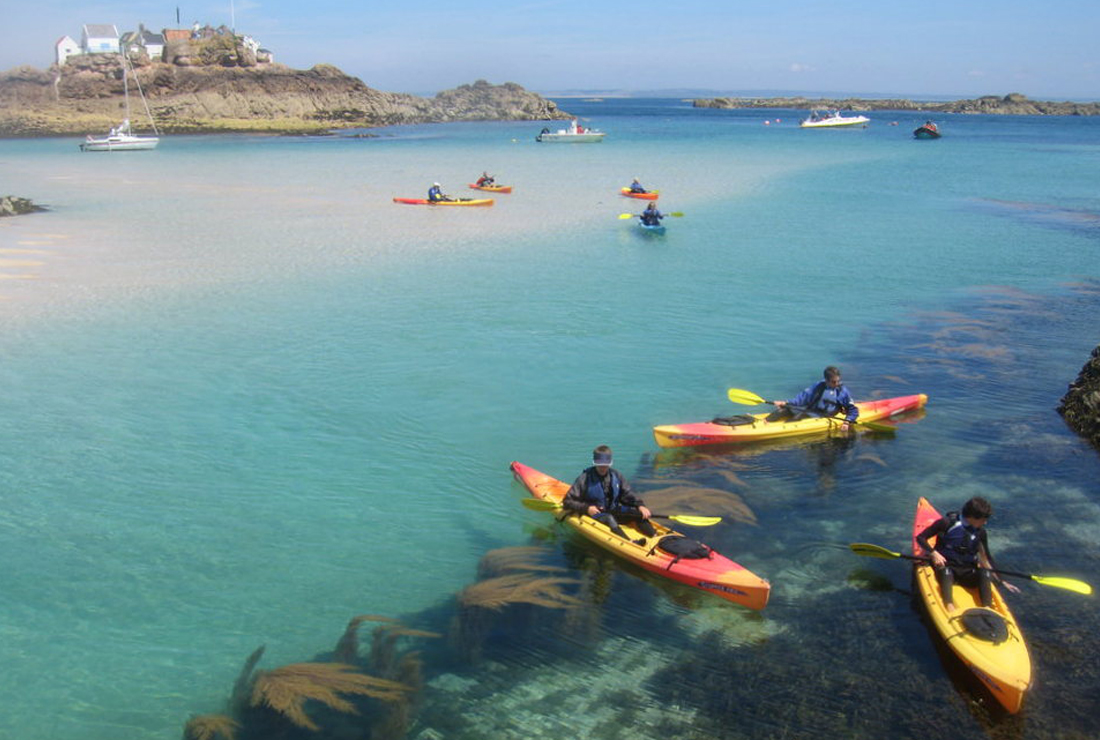
“The eco credentials of a business are becoming more important. We’ve started to get asked – especially from UK organisations – about our Green, Corporate Social Responsibility (CSR) & supplier screening policies.”
Jersey kayak adventures.

“We have been told by many guests that they choose to stay with us because of our green values and our Gold award. Other guests make frequent comments about our use of local and home-grown produce.”
Burnbank b&b, cookie policy.
By using this site you agree to our cookie policy

IMAGES
VIDEO
COMMENTS
For most European tourism providers today, embedding sustainability into all aspects of their business has become common practice. Before COVID-19, sustainable tourism was becoming increasingly important to the travelling public. Climate change leading to soaring temperatures, wildfires, floods, and other extreme weather events is now widely accepted to be a direct result of human behaviour.
A green tourism transition involves reconsideration of governance arrangements and collaboration across the tourism value chain. Increased multi-stakeholder governance in tourism has continued to develop through the pandemic, including through multi-lateral and global agreements and frameworks that provide guidance for national policy-making.
Travel and tourism are bouncing back from Covid-19 and are expected to reach $17 trillion by 2027. The increasing demand for sustainable tourism is not limited to eco-warriors who choose niche experiences and exclusive sustainability offerings. It is simply an appetite to travel sustainably and make more responsible choices.
Ecotourism business goals often include environmental protection and improved quality of life in addition to economic profit. Internal resources. Internal resources include human, financial, and physical resources available to assist in developing an ecotourism service or product. These may include personnel skills, existing finances to fund ...
The centrality of Tourism enterprises is related to the considerable impacts on the landscapes in which they operate. On the point, academics and policy makers have started to discuss about the difficult for Tourism enterprises to adopt business model based on sustainable paradigms such as the circular economy.
Post-pandemic, the flawed tourism model needs to adapt and transition to a fairer, people-centric and planet-friendly model. Every player in the travel and tourism supply chain, direct or indirect, needs to accelerate sustainable actions for the benefit of all local communities that depend on tourism for their livelihoods and opportunities ...
We invite you to read the Special Issue on business models in tourism, in the context of considering the principles of sustainable development. It is a collection of 14 articles published in a Special Issue of Sustainability MDPI in 20192021.The dynamic changes taking place in the world economy, social life, and the natural environment force entrepreneurs to change their business models.
We invite you to read the Special Issue on business models in tourism, in the context of considering the principles of sustainable development. It is a collection of 14 articles published in a Special Issue of Sustainability MDPI in 2019-2021. The dynamic changes taking place in the world economy, social life, and the natural environment ...
the business model concept in nature tourism, with particular focus on the extent and the way that this concept is discussed in relation to sustainability-related aspects. The business model concept is broadly adopted by business and management scholars as a strategic construct delineating the underlying logic through which value can be created and
Green Entrepreneurship in Tourism. María del Mar Alonso-Almeida, María José Álvarez-Gil. The Emerald Handbook of Entrepreneurship in Tourism, Travel and Hospitality. ISBN : 978-1-78743-530-8 , eISBN : 978-1-78743-529-2. Publication date: 11 July 2018.
In 2019, the total budget of the tourism industry was 6169.00 (Lakh BDT) for development, and total expenditure was 3848.43 (Lakh BDT). The Table 21.1 summarizes Bangladesh Parjatan Corporation's revenue, expenditure, and profit for the fiscal year 2019-2020. Table 21.1 Income, expenditure, and profit of Bangladesh Parjatan Corporation for ...
China as a relatively large group of ethnic minorities in a country, the existence of ethnic minorities on the development of society had a great impact. At present, mass tourism in minority areas has brought many positive benefits, but also produced negative effects such as environmental pollution, local culture extinction and over-commercialization, which affected the business model of ...
Through a combination of green business model and technological entrepreneurship, this comprehensive framework offers an in-depth overview of business models in the greentech field. ... 2020) because the hotel industry is responsible for more than a fifth of the tourism sector's entire ecological footprint (Melissen et al., 2016). By adopting ...
The concept of green tourism has evolved over time and is presently used with different meanings. The original one, spread during the 1980s, stands for small-scale tourism which involves visiting natural areas while minimizing environmental impacts. In this line, green tourism has been used interchangeably with such concepts as ecotourism ...
This section examines business models utilized inby tourism businesses in the Orinoquia and options for the development of sustainable tourism development. It will note specific characteristics of businesses in the region and their impact potential impact on sustainable growth. The section concludes with a review of the business solutions ...
The tourism and hospitality sector is no different. Over the past decade, publicly listed accommodation and experience providers grew revenue at 3 percent and 4 percent, respectively, roughly in line with global GDP growth. Accommodation providers increased their profits by five percentage points, while experience providers remained at an 18 ...
Sustainable tourism. Use this toolkit to help you become a sustainable tourism business, balancing the needs of people and place with profit. Whether you're starting out in tourism or have been in the industry for a while, you benefit by keeping up with visitors' demand for sustainability.
Sustainability in tourism is a goal and a path that must take into account the needs of visitors, the tourism sector, and communities, as well as the environmental, economic, and social impacts now and in the future. Sustainable tourism must make appropriate use of its territory and natural resources. The green tourism attraction of walkways is becoming very popular worldwide and needs to be ...
They could potentially develop a tourism business. However, the main reason for the lack of proper business activity is the lack of financial and investment resources. In the 2000s-2010s, a large - scale retraining of personnel was carried out through employment services in order to develop rural green tourism.
Park et al. (Citation 2024) utilized the Kano model and business analytics to identify both the satisfaction and dissatisfaction aspects of hotel green practices in customer experience. Their research findings aid hotel operators in crafting green strategies that minimize customer discomfort and enhance overall customer satisfaction ...
Although sustainable tourism development on a global scale remains a telic concept, the journey toward the goal of sustainability is vital for current and future economic, ecological, and socio ...
If you'd like to discuss how we can support your destination, contact our Managing Director, Scott Maclean. [email protected]. 07912 268 414. Green Tourism is a world leading certification provider. We work collaboratively with destination stakeholders and strategic partners GDS-Index to create top down, bottom up change.
Green Wing Energy Solutions. Since 2009, Green Wing Energy Solutions have helped many home and business owners benefit from an array of proven energy saving solutions. With over a decade of energy saving experience and a proven track record, we have and continue to help clients in the hospitality, care, manufacturing and service sectors.
Green Tourism promotes greener ways for businesses and organisations to operate, by offering our members advice on: The awards certification programme we run recognises the commitment of tourism businesses which are actively working to become more sustainable. Our Bronze/Silver/Gold awards are acknowledged worldwide as an indicator of good ...